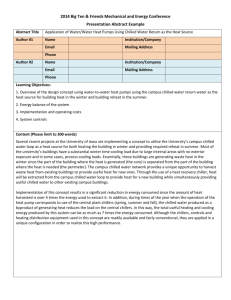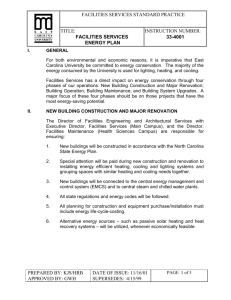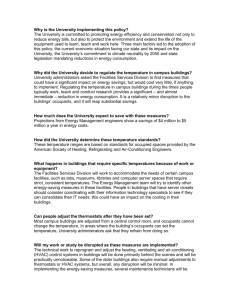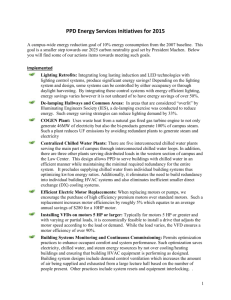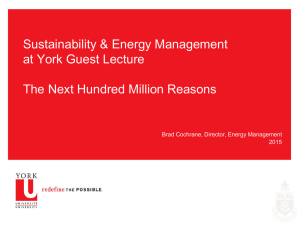58.5 KB doc
advertisement
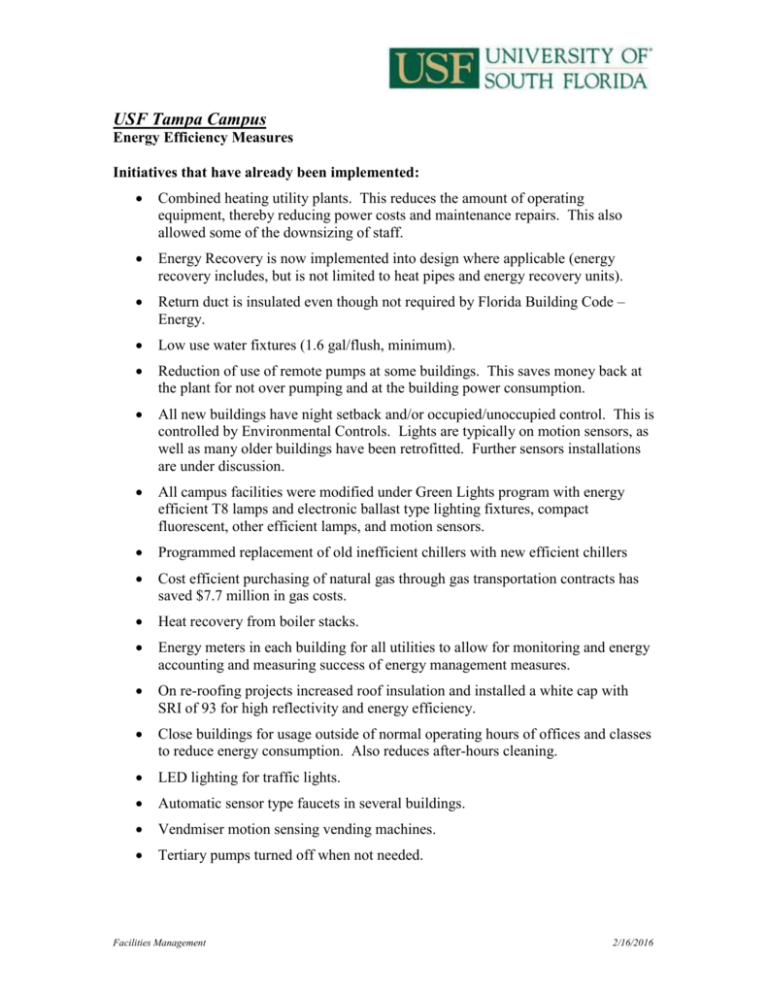
USF Tampa Campus Energy Efficiency Measures Initiatives that have already been implemented: Combined heating utility plants. This reduces the amount of operating equipment, thereby reducing power costs and maintenance repairs. This also allowed some of the downsizing of staff. Energy Recovery is now implemented into design where applicable (energy recovery includes, but is not limited to heat pipes and energy recovery units). Return duct is insulated even though not required by Florida Building Code – Energy. Low use water fixtures (1.6 gal/flush, minimum). Reduction of use of remote pumps at some buildings. This saves money back at the plant for not over pumping and at the building power consumption. All new buildings have night setback and/or occupied/unoccupied control. This is controlled by Environmental Controls. Lights are typically on motion sensors, as well as many older buildings have been retrofitted. Further sensors installations are under discussion. All campus facilities were modified under Green Lights program with energy efficient T8 lamps and electronic ballast type lighting fixtures, compact fluorescent, other efficient lamps, and motion sensors. Programmed replacement of old inefficient chillers with new efficient chillers Cost efficient purchasing of natural gas through gas transportation contracts has saved $7.7 million in gas costs. Heat recovery from boiler stacks. Energy meters in each building for all utilities to allow for monitoring and energy accounting and measuring success of energy management measures. On re-roofing projects increased roof insulation and installed a white cap with SRI of 93 for high reflectivity and energy efficiency. Close buildings for usage outside of normal operating hours of offices and classes to reduce energy consumption. Also reduces after-hours cleaning. LED lighting for traffic lights. Automatic sensor type faucets in several buildings. Vendmiser motion sensing vending machines. Tertiary pumps turned off when not needed. Facilities Management 2/16/2016 Initiatives that are currently underway or being planned in the future: Example of Physical Plant projects: BSF Building – upgrade the air handlers and exhaust fans. This laboratory building is a large energy user. Heat pipes are under consideration to reduce chilled and hot water load on the outside air units. The AHUs are being refurbished and new variable speed drives added. The exhaust fans will be replaced and allow better control of the occupied/unoccupied modes of the laboratories. Researching if previous energy data is available so it can be used as a benchmark against the improvements. Construction is expected to start soon. Design standards in place that meet or exceed ASHRAE Standard 90.1-07. This follows Governor Crist’s goal of construction standards shall be 15% above FBC2007. New highly efficient primary variable chiller plant starting implementation stage that will provide capacity and redundancy to the campus chilled water loops. This will allow more efficient chillers and pumping to offset older equipment. Certify buildings as either LEED-NC or LEED-EB. Capture of storm water to be reused for irrigation and possible plant process water. Chilled water storage for energy cost reduction Induction lighting for parking garages and high bay installations T5 fluorescent lighting in new facilities Solar photovoltaic panels for electricity generation. Facilities Management 2/16/2016 USF Sarasota Campus Energy Efficiency Measures Initiatives that have already been implemented: Setback HVAC equipment running cycles to reduce hours of operation by 60 hours/week. Setback electrical timers to reduce hours of parking lot and building exterior lighting. Installed CO2 sensors in air handlers to reduce demand when classrooms are unoccupied. Modified ductwork to increase air flow to air handlers and increase operating efficiencies. Raised chilled water temperatures from 47 degrees to 54 degrees to decrease chiller load. Lowered electrical reheat set points to reduce demand for electric reheat. USF-SM received $8,310.00 in FPL rebates for completing the above measures. Initiatives that are currently underway or being planned in the future: Provide additional ventilation in chiller yard to decrease chiller operating temperatures and provide increased operating efficiencies. Install digital HVAC controls software monitoring to notify operations personnel when electrical usage demands exceed programmed range. Install automatic light shut-offs in all classrooms. Design and construct a thermal storage system for the main chiller plant to reduce operating costs by manufacturing ice during off-peak demand hours. Replace deteriorated, inefficient chiller and air handlers at Viking Complex. USF-SM anticipates $40,000.00 in FPL rebates when the above measures are completed. Facilities Management 2/16/2016 USF St. Petersburg Campus Energy Efficiency Measures Initiatives that have already been implemented: Buildings HVAC systems are shutdown over the weekends except for the research lab buildings. Night time HVAC setback mode has been extended. Energy efficient T-8 fluorescent lamps have been installed in all buildings. Numbers of lamps have been reduced in all fixtures up to a max of 50% while maintaining minimum acceptable lighting levels. Energy Misers have been added to most vending machines. Daytime temperature settings have been raised to 74 deg in classrooms and 78 deg in offices. 50% minimum reduction in waste generation has been targeted. Efforts have been increased to encourage campus wide recycling. Initiatives that are currently underway or being planned in the future: All future buildings (including the Science Technology/Gen'l Academic Building) will be LEED Certified with our goal toward achieving silver certification or better. Apply window film to existing buildings to both increase wind resistance and reduce solar heat gain. Insulate ceilings where return air plenums are utilized in existing buildings. Implement xeriscape landscape materials in as many applications as applicable. Reduce paving where ever possible and replace with landscape materials which will reduce vehicle use on campus and provide more water absorption and less runoff. Facilities Management 2/16/2016



